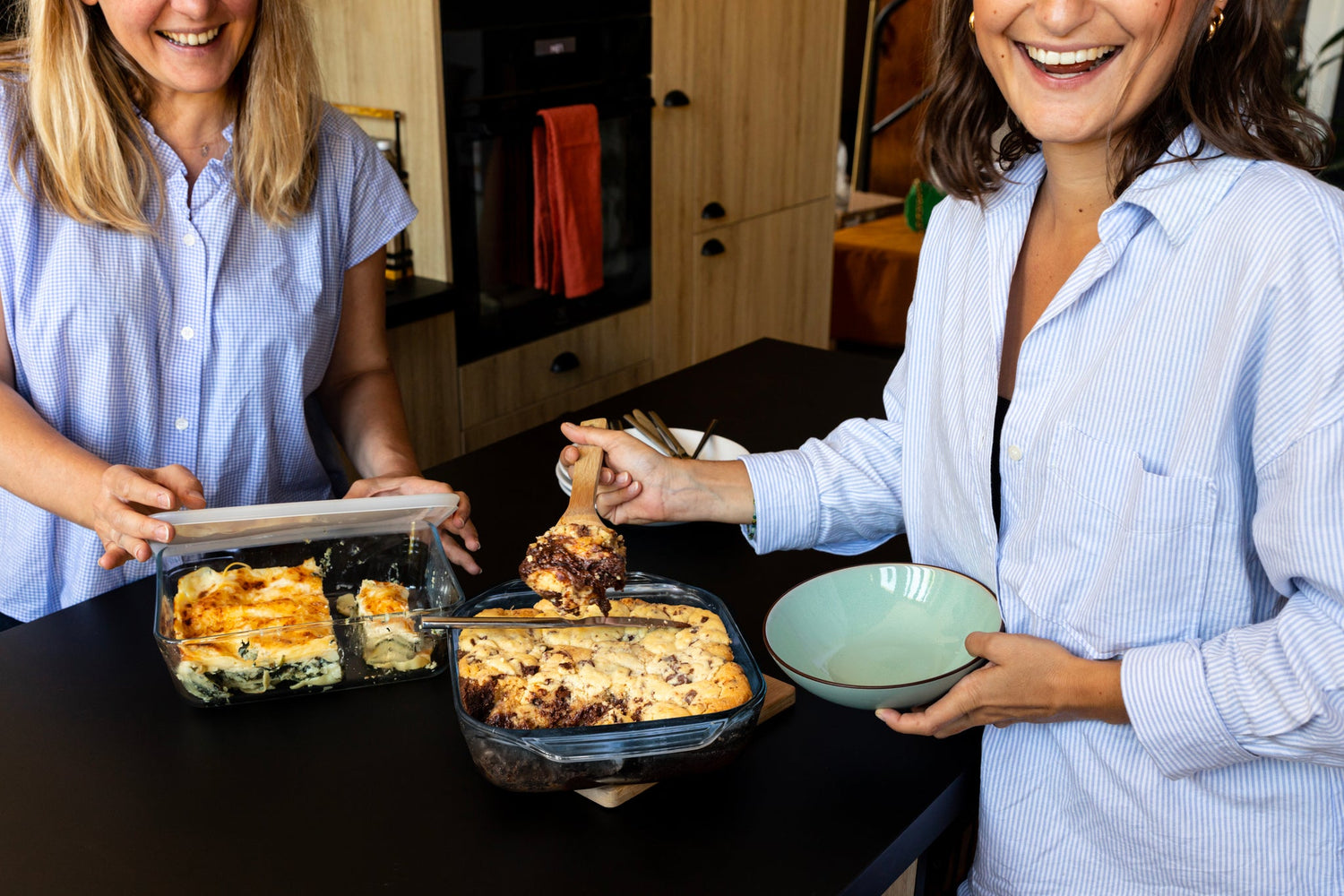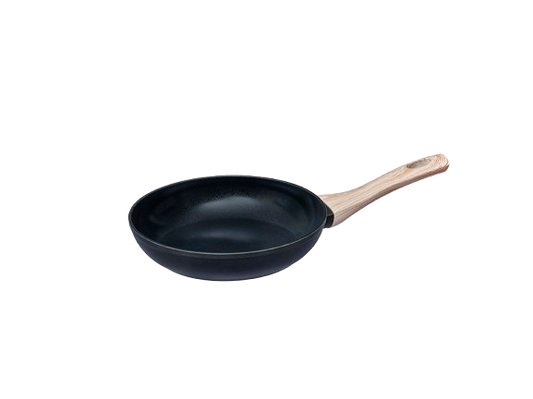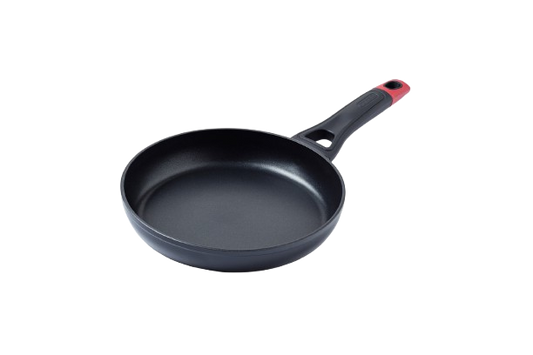Which frying pan to choose based on use and material?
Alongside the saucepan, the frying pan is the star of your cookware set. Pyrex® has designed a dual collection of frying pans to meet all your needs — whether frying, grilling, reheating, sautéing vegetables, or even making crêpes. Available in different sizes and compatible with all types of hobs, a frying pan is an essential in every kitchen cupboard.
If you’re wondering which frying pan to choose for healthy, economical cooking, which size to go for, how to ensure compatibility with your hob, and what non-stick properties to look out for, this Pyrex® frying pan guide has all the answers.
How to choose the right frying pan?
To cook efficiently, quickly, and healthily, you should start by choosing a frying pan with a thick base, compatible with your hob type (gas, electric, or induction), ideally with a PFAS-free non-stick coating, and with a comfortable grip thanks to an ergonomic handle suited to the size of the pan.
At Pyrex®, we have chosen to design all our non-stick frying pans without PFAS.
Because a frying pan should always be versatile, you can also choose from its variations — a sauté pan, a crêpe pan, or a wok.
Choosing a frying pan by material: aluminium
Pyrex® has chosen aluminium as the main material for its frying pans, coated with a PFAS-free non-stick surface.
Why aluminium?
Quite simply, because of its many advantages:
-
Lightweight and easy to handle
-
Excellent heat conductivity
-
Fast and even heating
-
Long-lasting durability
-
Excellent value for money
Since a frying pan (and saucepan) is in direct contact with both food and heat, aluminium and stainless steel are among the preferred materials. Other options exist, such as ceramic, copper, or cast iron, though they are less commonly found in modern kitchens.
► Good to know: aluminium from one of our ranges is recycled and recyclable, helping to protect the environment.
Choosing a frying pan by coating
It’s not always easy to decide between a pan without a non-stick coating — such as stainless steel or cast iron — and one with a non-stick coating, like the Pyrex® frying pan ranges.
By choosing a non-stick frying pan, you can:
-
Prepare delicate dishes such as eggs or fish
-
Reduce the amount of fat needed for cooking
-
Clean and maintain your Pyrex® pan more easily
► Tip: when choosing a frying pan with a non-stick coating, it’s the best option if you want easy maintenance, healthier cooking with less fat, and dishwasher-safe use.
Choosing a frying pan based on hob compatibility
The arrival of induction cooking has changed how we think about cookware compatibility. Induction requires pans with a ferromagnetic base, which ensures:
-
Rapid and even heating
-
Energy savings, since induction only heats the activated cooking zone with no heat loss
-
Greater safety, as induction heats only when the pan is placed on the hob and does not spread heat around the cookware
Every Pyrex® frying pan is compatible with gas, traditional electric hobs, halogen, ceramic, and of course, induction.
Choosing a Pyrex® frying pan by diameter
A single person doesn’t necessarily need a large pan. To help you select the right frying pan, here’s a quick guide to pan sizes and their typical uses:
-
20 cm pan – perfect for fried or scrambled eggs for one, blinis, pancakes, or reheating small portions of vegetables.
-
22 cm pan – great for an omelette, medium-sized crêpes, or cooking a steak, escalope, or fish fillet.
-
24 cm pan – suitable for two people. Can cook two pieces of meat, sautéed vegetables, or fried potatoes.
-
26 cm pan – offers more comfort and slightly larger portions.
-
28 cm pan – ideal for 3 to 4 people, large enough for whole trout or a family omelette with filling.
-
30 cm pan – designed for family meals for 4 or more.
How to make the right choice when buying a Pyrex® frying pan
Before purchasing your Pyrex® frying pan, always make sure to:
-
Check the type of hob you have.
-
Choose the diameter according to the size of your household.
-
Consider whether you might actually need a sauté pan for slow-cooked dishes.
How to care for a PFAS-free Pyrex® non-stick frying pan
Cooking inevitably leads to wear and tear on your pan, especially if you don’t use utensils that protect the non-stick coating. Always favour wooden, plastic, or heat-resistant silicone spoons and spatulas, which are far less abrasive than metal utensils.
When it comes to cleaning your Pyrex® pan, the coating is dishwasher-safe. You can also wash it by hand with a soft sponge and washing-up liquid — but never use the abrasive green side of the sponge, as this can scratch or wear the coating prematurely.
For storage, you can either hang your pan on the kitchen wall or stack it in a cupboard, making sure to place felt protectors between each pan to avoid scratching the non-stick surface.
One last tip that’s often overlooked: always let your pan cool down before rinsing it under water to avoid thermal shock.
FAQ about choosing a frying pan
Why is it important to choose the right diameter for a frying pan?
By selecting the right diameter, you ensure optimal and even cooking, while reducing the risk of food burning around the edges. A pan that’s too large for the hob will waste heat and unnecessarily warm areas of the pan without food.
Which material is best for a non-stick frying pan?
Aluminium is the ideal base for a non-stick pan. Lightweight and quick to heat, it allows for easy cleaning and perfectly even cooking thanks to its excellent heat conductivity.
How can I tell if my frying pan is induction-compatible?
All Pyrex® frying pans are induction-friendly (except for a few crêpe pans). If in doubt, simply place a small magnet on the base of your pan: if it sticks, your pan is suitable for induction hobs.
Why choose a non-stick pan without PFAS for healthier cooking?
The non-stick coating should be PFAS-free, as is the case with Pyrex® pans. This also allows you to cook with less fat, for healthier results.
How can I extend the life of a non-stick frying pan?
Use wooden, plastic, or heat-resistant silicone utensils whenever possible, and clean by hand with a soft sponge and washing-up liquid, or in the dishwasher. Never heat your pan empty at a high temperature, as this can damage the coating.











